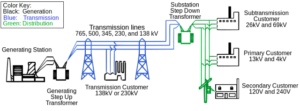Moving-iron Power Factor Meter
Moving Iron Power Factor meters are three-phase power factor meters. These power factor meters consist of a moving iron pointer. It consists of three fixed coils R, Y, and B. These coils are connected to three three-phase supply on which it is to be used.
Construction

These power factor meters have three fixed coils as mentioned above and it has three terminals of R,Y and B with axes and these fixed coils are connected mutually at 120 degrees. These coils intersects on the center line of the instrument. A fixed coil C is located at the center of the three fixed coils. This coil C is connected in series with high resistance across one of the lines. The coil B is threaded by the spindle. It carries an iron cylinder and the sector-shaped iron vanes are fixed on it. The spindle has no control springs and it carries a pointer and damping vanes.
Working
The coil C produces alternating flux with the three current coils and it acts on a moving system for the deflection of a pointer. The angular deflection of the iron vanes from the line M, N is equal to the phase angle φ. The rotating field of the coils of R, Y, and B turns the moving iron continuously in the direction of a rotating flux. The high resistance for the moving iron is used to reduce the eddy current in it.
Types of Power Factor Meter
he power factor meter is of two types. They are
- Electrodynamometer
- Single Phase Electrodynammeter
- Three Phases Electrodynamometer
- Moving Iron Type Meter
Advantages Of Moving-iron Power Factor Meter
- These meters are strong and cheap.
- Their scales are up to 360 degrees.
- There are no electrical connections in the moving parts.
Disadvantages Of Moving-iron Power Factor Meter
- These instruments have so many errors.
- These instruments are not accurate.
- These instruments have hysteresis losses and eddy current losses in their iron parts.



